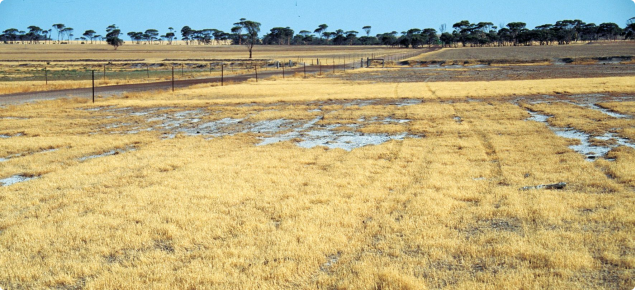The volunteer pasture option
The assumption is that this option will include grazing, and therefore the site needs to be fenced to allow grazing management. All vegetation establishment is from surrounding or onsite species.
This option suits the following conditions
- properties with livestock
- slightly saline and waterlogged sites where finances, experience or other factors are limiting
- moderately to severely saline sites with low to moderate waterlogging and rarely inundated
- areas large enough to manage as a grazing unit
- climatic zones where perennials rather than annuals are likely to establish. Mediterranean climates (as in south-west Western Australia (WA) may revegetate with annuals, which are of less use to fill feed gaps.
Benefits of this option
The benefits are:
- low cost of establishment
- some grazing value
- increased profit relative to 'do nothing', and good marginal returns
- the soil surface will stabilise with more ground cover
- there will be slightly less salt exported from the site
- the site is less susceptible to erosion
- visual amenity is improved
- with only a fencing cost, the cost of establishment failure is low.
At the assumed levels of production, fencing saltland to control grazing has been profitable in all southern regions of Australian. In WA the benefit of fencing is low, about $15/ha, compared with $90/ha in NSW and $60/ha in SA.
In the drier, more Mediterranean grainbelt of WA, the increase from fencing may be much less than an increase from pasture improvement. In WA, pasture improvement involves planting saltbush, which provides forage and improved pasture in autumn when farm feed is in short supply.
Problems with this option
- The mix of volunteer pasture species may not be the most suitable or productive.
- The site will probably need surface water management, and this may change the suitable options (see below).
- There is the cost of fencing and adding water supplies.
Whole farm options
- Use shallow relief drains onsite to prevent inundation where possible.
- Use surface water management structures upslope to divert water to grassed waterways and a safe discharge.
- Use revegetation on less salt affected areas around the severely saline site.
Identifying suitable sites for this option
Suitable sites will have:
- little inundation
- mild to moderate waterlogging
- slight to moderate salinity (ECe of 200–800 milliSiemens per metre)
- local seed sources for volunteer establishment
- indicator plants for slight to moderate salinity are present
- sufficient size to justify fencing and garzing management.
Managing the option and site
Establishment
- Scarify or harrow bare crusted soils, to provide niches for shed seed to lodge and germinate: in Western Australia, do this in March–April when the small leaf bluebush is shedding its mature seed.
Grazing management
- Graze when improved pastures are at lowest value (periods of feed gap).
- Follow feed on offer (FOO) recommendations.
- Use the recommended grazing system for the pasture type (shrubs, herbaceous perennials, annuals).
- Remove livestock if their condition declines.
- Remove livestock if bare areas increase.

